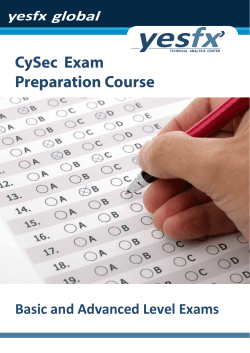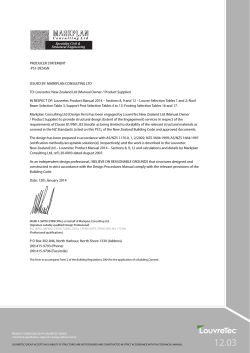
KS3 Biology 7D Variation and Classification © Boardworks Ltd 2004
KS3 Biology 7D Variation and Classification 1 of 20 34 © Boardworks Ltd 2005 2004 Contents 7D Variation and Classification Spotting variation What causes variation? The classification system Summary activities 1 2 of 20 34 © Boardworks Ltd 2005 2004 Spot the differences What are the differences between these organisms? 1 3 of 20 34 © Boardworks Ltd 2005 2004 Spot the differences There are lots of differences between these organisms. For example: some have leaves; some lay eggs; some eat plants. These organisms are different because they are all from different species. 1 4 of 20 34 © Boardworks Ltd 2005 2004 Spot the differences – same species There are also differences between organisms of the same species. For example, these people are all from the same species but how many differences between them can you spot? 1 5 of 20 34 © Boardworks Ltd 2005 2004 What is variation? Even though people are all from the same species, there are many ways in which they are different from each other. Some of them are male, some are female, some are tall, some are short. The differences that occur both between different species and within the same species are called variation. 1 6 of 20 34 © Boardworks Ltd 2005 2004 Contents 7D Variation and Classification Spotting variation What causes variation? The classification system Summary activities 1 7 of 20 34 © Boardworks Ltd 2005 2004 What causes variation? Variation is caused by two factors: 1. Some features are cause by inherited factors. These are features that are passed on from parents. For example, natural hair colour is an inherited feature. 2. Some features are caused by environmental factors. These are features that are affected by the surroundings. For example, someone can be born with brown hair which then gets lighter in the Sun or might be dyed a different colour. 1 8 of 20 34 © Boardworks Ltd 2005 2004 Environmental or inherited? 1 9 of 20 34 © Boardworks Ltd 2005 2004 Environmental or inherited? Sometimes it is not easy to determine whether a feature is inherited or environmental. Scientists have now decided that only four characteristics are truly inherited and not affected by the environment at all. Can you guess what they are? 1. 2. 3. 4. 1 10ofof20 34 natural eye colour natural hair colour blood group some inherited diseases © Boardworks Ltd 2005 2004 What about other features? Some features are caused by a mixture of inheritance and the environment, for example, nose shape. Someone might have a nose that looks just like their mum’s. But if they were in an accident, they might break their nose and put a kink in it. So their initial nose shape was probably inherited but over time it is likely to have been affected by the environment. How can the environment affect skin colour? 1 11ofof20 34 © Boardworks Ltd 2005 2004 Contents 7D Variation and Classification Spotting variation What causes variation? The classification system Summary activities 1 12ofof20 34 © Boardworks Ltd 2005 2004 Common features There is a lot of variation between organisms, but some organisms also have many features in common. Compare a cow and a dolphin, you might think they do not have many things in common but you will be surprised. How many features common to both cows and dolphins can you think of? 1 13ofof20 34 © Boardworks Ltd 2005 2004 Common features 1 14ofof20 34 © Boardworks Ltd 2005 2004 What is classification? Cows and dolphins have several features in common. Many other organisms also share common features. Scientists use common features to put organisms into groups. Grouping organisms based on their common features is called classification. 1 15ofof20 34 © Boardworks Ltd 2005 2004 Classification – grouping organisms Sort these organisms into four groups based on their similarities. 1 16ofof20 34 © Boardworks Ltd 2005 2004 Classification – grouping organisms One way that a scientist might have grouped these organisms is to put them into the following four groups: 1. Plants 2. Birds 3. Mammals 4. Reptiles These groups come from the scientific system for classifying organisms. 1 17ofof20 34 © Boardworks Ltd 2005 2004 The classification system The classification system begins with very big groups that include a lot of organisms and then moves down to smaller groups made up of fewer organisms. The biggest groups are called the kingdoms. All living things are classified into five different kingdoms. living things plants 1 18ofof20 34 animals fungi monera protoctista © Boardworks Ltd 2005 2004 The five kingdoms 1 19ofof20 34 © Boardworks Ltd 2005 2004 Which kingdom? 1 20ofof20 34 © Boardworks Ltd 2005 2004 Classifying animals How can different types of animals be classified? 1 21ofof20 34 © Boardworks Ltd 2005 2004 Animal classification The animal kingdom is divided into two groups: animals vertebrates Vertebrates are animals that have a backbone. They have a firm body because of the muscles that connect to their skeleton. 1 22ofof20 34 invertebrates Invertebrates are animals that do not have a backbone. They have soft inner bodies which are held in shape by a flexible covering of outer cells or by a hard covering called an exoskeleton. © Boardworks Ltd 2005 2004 Animal classification 1 23ofof20 34 © Boardworks Ltd 2005 2004 Animal classification – activity 1 24ofof20 34 © Boardworks Ltd 2005 2004 Features of vertebrates 1 25ofof20 34 © Boardworks Ltd 2005 2004 Which type of vertebrate? 1 26ofof20 34 © Boardworks Ltd 2005 2004 Which classification group? 1 27ofof20 34 © Boardworks Ltd 2005 2004 The odd one out In terms of classification, which of these organisms is the odd one out and why? sprat tuna shark perch whale trout sturgeon seahorse salmon flounder The whale is the odd one out. All of the rest are fish, a whale is a mammal. 1 28ofof20 34 © Boardworks Ltd 2005 2004 The odd one out In terms of classification which of these organisms is the odd one out and why? kiwi penguin duck platypus raven owl robin swan pigeon eagle The platypus is the odd one out. All of the rest are birds, a platypus is a mammal. 1 29ofof20 34 © Boardworks Ltd 2005 2004 The odd one out In terms of classification which of these organisms is the odd one out and why? caterpillar ant lice horse fly moth scorpion cicada ladybird silverfish cockroach The scorpion is the odd one out. All of the rest are insects, a scorpion is an arachnid. 1 30ofof20 34 © Boardworks Ltd 2005 2004 Contents 7D Variation and Classification Spotting variation What causes variation? The classification system Summary activities 1 31ofof20 34 © Boardworks Ltd 2005 2004 Glossary classification – Sorting living things into groups. environmental variation – Differences between organisms that are due to the environment. inherited variation – Differences between organisms that are due to their parents. invertebrate – An animal without a backbone. kingdom – The largest groups that living things are sorted into. species – A group of organisms that can reproduce with each other to produce viable offspring. variation – The differences between living things. vertebrate – An animal with a backbone. 1 32ofof20 34 © Boardworks Ltd 2005 2004 Anagrams 1 33ofof20 34 © Boardworks Ltd 2005 2004 Multiple-choice quiz 1 34ofof20 34 © Boardworks Ltd 2005 2004
© Copyright 2025

















